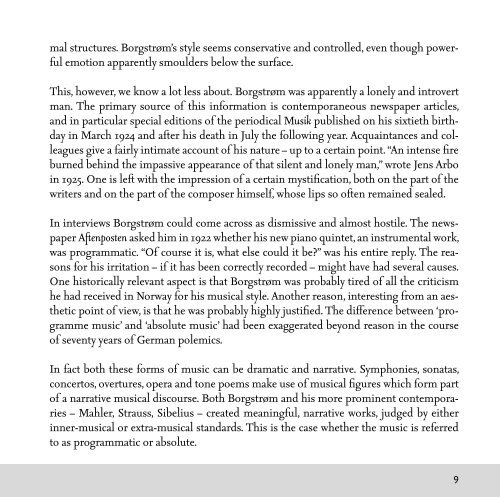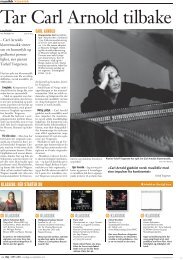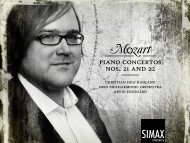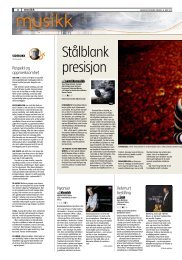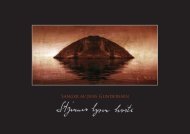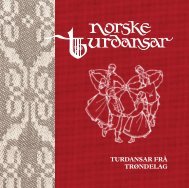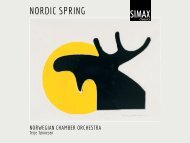Hjalmar Borgström
Hjalmar Borgström
Hjalmar Borgström
You also want an ePaper? Increase the reach of your titles
YUMPU automatically turns print PDFs into web optimized ePapers that Google loves.
mal structures. Borgstrøm’s style seems conservative and controlled, even though powerful<br />
emotion apparently smoulders below the surface.<br />
This, however, we know a lot less about. Borgstrøm was apparently a lonely and introvert<br />
man. The primary source of this information is contemporaneous newspaper articles,<br />
and in particular special editions of the periodical Musik published on his sixtieth birthday<br />
in March 1924 and after his death in July the following year. Acquaintances and colleagues<br />
give a fairly intimate account of his nature – up to a certain point. “An intense fire<br />
burned behind the impassive appearance of that silent and lonely man,” wrote Jens Arbo<br />
in 1925. One is left with the impression of a certain mystification, both on the part of the<br />
writers and on the part of the composer himself, whose lips so often remained sealed.<br />
In interviews Borgstrøm could come across as dismissive and almost hostile. The newspaper<br />
Aftenposten asked him in 1922 whether his new piano quintet, an instrumental work,<br />
was programmatic. “Of course it is, what else could it be?” was his entire reply. The reasons<br />
for his irritation – if it has been correctly recorded – might have had several causes.<br />
One historically relevant aspect is that Borgstrøm was probably tired of all the criticism<br />
he had received in Norway for his musical style. Another reason, interesting from an aesthetic<br />
point of view, is that he was probably highly justified. The difference between ‘programme<br />
music’ and ‘absolute music’ had been exaggerated beyond reason in the course<br />
of seventy years of German polemics.<br />
In fact both these forms of music can be dramatic and narrative. Symphonies, sonatas,<br />
concertos, overtures, opera and tone poems make use of musical figures which form part<br />
of a narrative musical discourse. Both Borgstrøm and his more prominent contemporaries<br />
– Mahler, Strauss, Sibelius – created meaningful, narrative works, judged by either<br />
inner-musical or extra-musical standards. This is the case whether the music is referred<br />
to as programmatic or absolute.<br />
9


